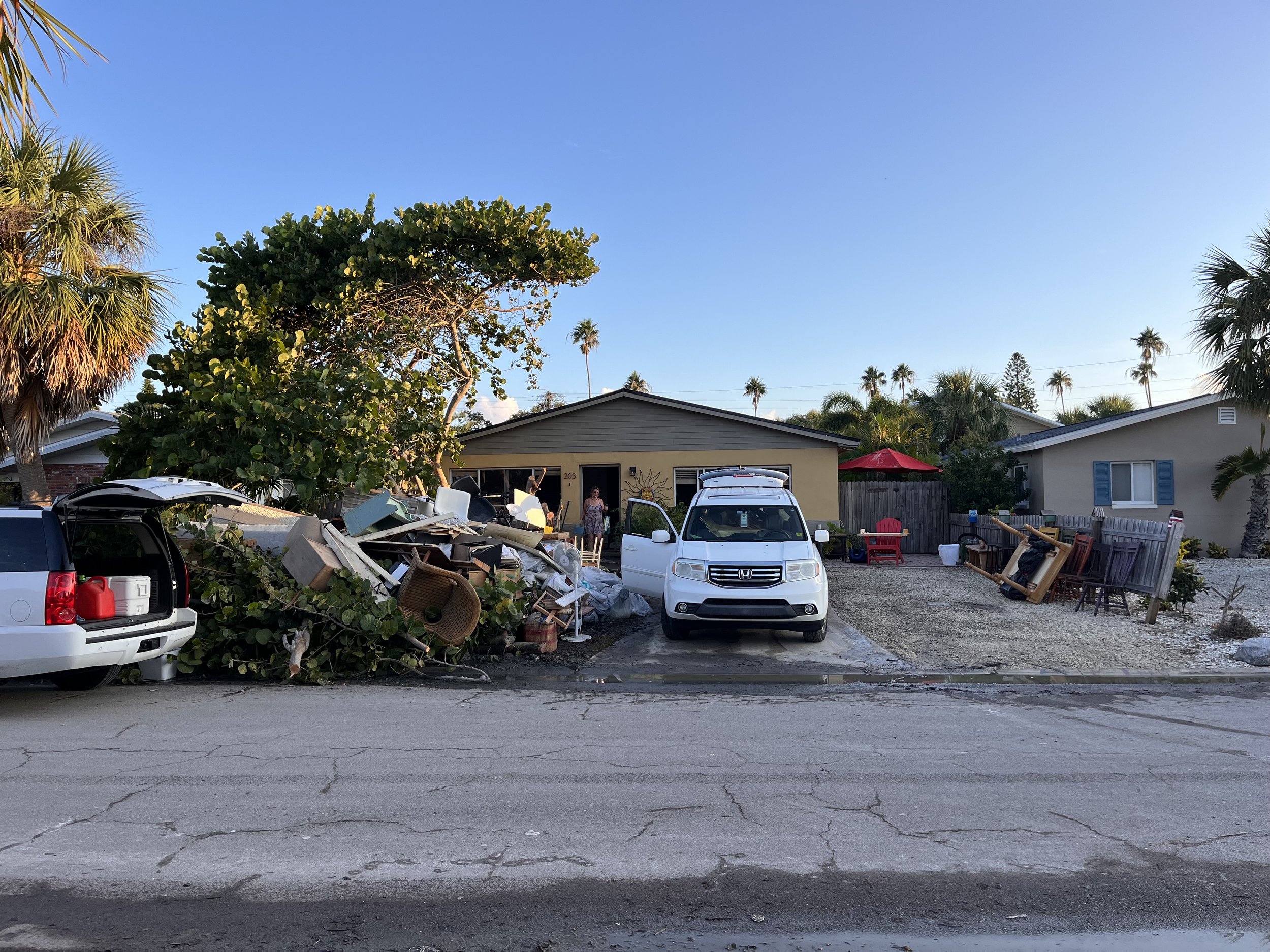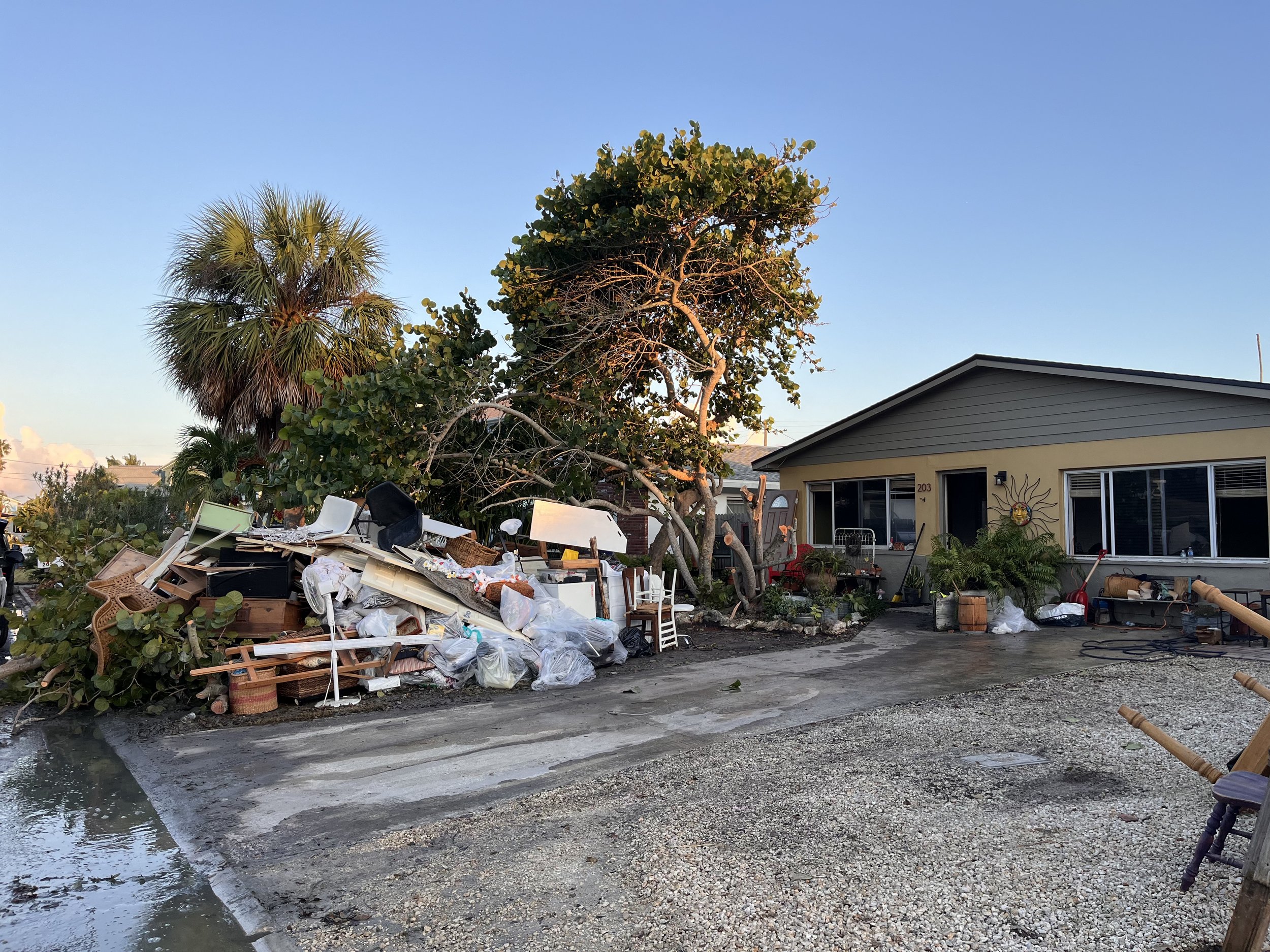The Hundred Year Storm: Devastation and Uncertainty Remain in the Barrier Islands
Image Courtesy: Morgan Harms
Nestled on the west coast of Florida, 11 barrier islands stretching for 35 miles call Pinellas County their home. Bordered by Tampa Bay, the most densely populated county in Florida has been spared the wrath of major hurricane damage for quite some time now. With over a century since the last major hurricane made a direct hit, the residents of this quiet coastal area had settled into the idea that they were safe.
This isn’t to say that every hurricane season hasn’t been a nail-biter because threats of a major direct hit had come many times before, but the area always seemed to remain untouched. Legends of Native Americans who blessed the land have been passed around for decades. Eventually, every time a tropical threat loomed, the lot of the population began brushing it off. And the 2024 hurricane season was no different.
So, as Hurricane Helene came creeping through the Gulf of Mexico, many of the locals weren’t too worried. But they should’ve been.
Although evacuations were mandatory on the barrier islands, many didn’t leave. They stayed with their homes, minds set on a clean break from danger. Although it made landfall far north of the islands, as Helene inched by, those who stayed soon wished they hadn’t.
After dark, water began rushing inland, first a foot, then another. And it quickly rose driveways into the cracks and crevices of homes, and as residents hunkered down inside them, they watched as the warm gulf waters flowed in.
They stood by helplessly as their lives went underwater. And when they realized the rushing water wasn’t slowing anytime soon, they were forced to abandon their homes, as everything drowned within it.
Residents in single-story homes began swimming across streets, pets and valuables held above their heads, to the safety of their neighbors' elevated homes. Others sought safety on the roof of their house or car. Some residents even became heroes, rescuing the less-able neighbors crying for help around them.
They watched as the Gulf of Mexico became one with the land and pleaded that it didn’t go any higher. Houses, businesses, and lives underwater. An anomaly that none of them had experienced before.
Image Courtesy: Morgan Harms
As the sun rose and the water receded, they faced harsh realities. In the span of one night, people lost everything. Their homes, their businesses, their jobs; some lost a friend, a neighbor, a loved one.
While they stood in the ruins, heartbreak sounded loud throughout the coastal neighborhoods. But as they took their first walk through the remains of their homes and businesses, they looked next door and saw their neighbors doing the same.
It’s an unfathomable concept, really. Building a home, a business, a life. Falling in love with the place you live, then watching it get destroyed, unable to recognize it in the daylight. You come to the realization that you have no choice but to start over.
As they went through their homes, what was salvageable was minimal. And their soaked furniture, clothes, keepsakes, and other belongings were tossed in their yard. Even their walls, their counters, their doors, their appliances…entire lives on the side of the road for the world to see.
And before they could even catch a breath, Hurricane Milton loomed. Not only was it another major hurricane threat, it was set to make a direct hit in the Bay Area. Weather forecasters and experts were calling for further potentially catastrophic effects. It was like a punch to the face from Mother Nature. The mentally and physically exhausted residents packed up their remaining belongings, millions heading evacuation orders this time around. Some still stayed. The barrier islands prepared for the worst but hoped for the best.
Once again, the Tampa Bay Area dodged a bullet as Hurricane Milton drove south for landfall.
While flood damage in the area wasn’t a major issue this time around, hurricane winds blew strong, adding fuel to the fire.
Power was lost, trees were down, and debris littered the streets. And so, the tired residents of Pinellas County’s islands began clean-up once again.
It’s been a month since Helene and Milton’s wrath, so where are the locals now? As hard as it may be, people are forced to continue on. Those whose homes are unlivable or completely lost have found temporary housing. They went back to work or worked to get their jobs back open. Some are looking for new jobs after losing theirs to the storm. Some have begun receiving FEMA and insurance checks; others are still waiting.
Image Courtesy: Morgan Harms
The majority have come to a halt on the restoration/rebuilding of their home, and this is due to Pinellas County’s Substantial Damage Rule. According to the county-wide rule, if the cost to repair the home is 49% or more of its value without the land, the home is considered Substantially Damaged. After the natural disaster, the county made a list of homes that were likely damaged after the storm. The county then sends inspectors to the property to assess the damage. If you live on one of the barrier islands and your property is determined Substantially Damaged, you must rebuild to elevate your home. These policies are in compliance with the National Flood Insurance Program (NFIP).
While this regulation is intended to prevent future flood damage in residences and businesses, it can be difficult for many to afford. For most, insurance and FEMA checks do not provide enough for residents to completely rebuild their homes. If these residents choose to ignore the policy and restore their home deemed Substantially Damaged rather than rebuild to code, homeowners and the county can face consequences such as probation or suspension from the NFIP, loss of eligibility for federally funded disaster assistance programs, foreclosure, and loss of access to federally regulated mortgages.
Yes, the hurricanes have passed, but the physical and emotional damage has not. While the Pinellas County barrier island residents face an uncertain future, they try to remain hopeful. The area is broken but not beyond repair.
As climate change continues, the Gulf of Mexico becomes warmer, and hurricane seasons become more active. It raises a question many are afraid to know the answer to: If they choose to rebuild, will they be knocked down again?
Strike out,
Morgan Harms
Boca Raton
Morgan Harms is a Content Writer for Strike Magazine Boca. She is a Pisces mermaid with a love for the ocean. She spends her free time daydreaming, wave-watching, and blasting whatever music she’s into that day. You can reach her by email at morganjharms@gmail.com or on Instagram @morganjharms and @morganjharmswrites.




